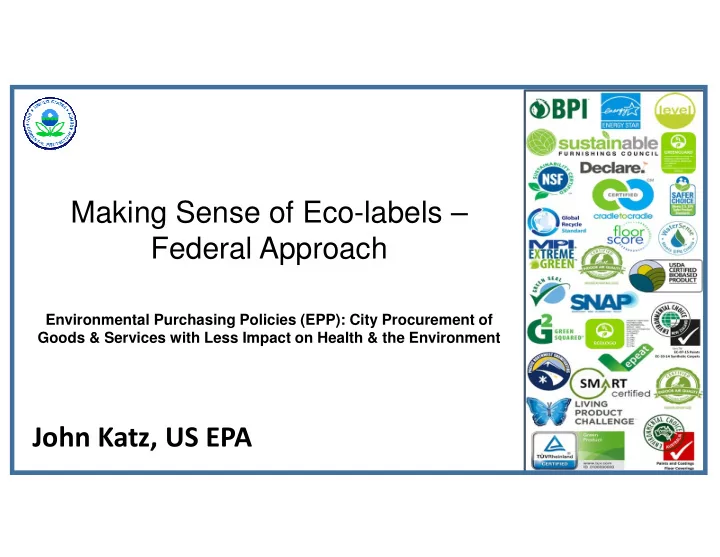

Making Sense of Eco-labels – Federal Approach Environmental Purchasing Policies (EPP): City Procurement of Goods & Services with Less Impact on Health & the Environment John Katz, US EPA
Why Purchasing? Why Purchasing? Why Purchasing? Why Purchasing? The Federal Footprint • � Procurement represent roughly 2.7% of USGDP and influence much more � Spent $474 billion on goods and services in FY16 � Spend $90 billion annually on IT equipment and services � Spend $3.5 billion annually to provide energy to its facilities � Owns/leases 630,000 vehicles worldwide � Manages or owns nearly 1 of every 5 acres in the U.S. • State and local government spend $1.5 Trillion annually on goods and service 2
The Environmentally Preferable Purchasing (EPP) Program The Environmentally Preferable Purchasing (EPP) Program The Environmentally Preferable Purchasing (EPP) Program The Environmentally Preferable Purchasing (EPP) Program Significant demand for Markets need sound, reliable environmentally preferable products information to perform and services, but many definitions of efficiently. what is “green.” U.S. businesses want agreed The federal government has definitions of what constitutes environmental preferability for been a key player . their product/service sector Federal Acquisition Regulations (FAR) 48 CFR Part 23.703 • Agencies must "(M)aximize the utilization of environmentally preferable products and services (based on EPA-issued guidance)." 3
EPP Program: What We Do EPP Program: What We Do EPP Program: What We Do EPP Program: What We Do GOAL: Harness federal purchasing power to create market opportunities for industry innovators and green markets • Coordinate and provide EPA technical input for key product sustainability standard development efforts • Assess and recommend environmental standards & ecolabels • Help federal agencies procure products and services conformant with our recommended standards and ecolabels • Help businesses sell greener products to the federal government • Measure the economic and environmental benefits of this work 4 Office of Pollution Prevention and Toxics
E E COLABELS THE M M ARKETPLACE IN 1995 (13) 1995 (13) E E M M 1995 (13) 1995 (13) COLABELS FOUND COLABELS COLABELS FOUND IN FOUND FOUND IN THE IN IN THE THE ARKETPLACE IN ARKETPLACE ARKETPLACE IN IN 5
E E COLABELS THE G G LOBAL LOBAL M M ARKETPLACE TODAY (460+) (460+) E E G G M M (460+) (460+) COLABELS FOUND COLABELS COLABELS FOUND IN FOUND FOUND IN IN IN THE THE THE LOBAL LOBAL ARKETPLACE ARKETPLACE ARKETPLACE TODAY TODAY TODAY 6
M M ULTI ULTI - - STAKEHOLDER STAKEHOLDER A A PPROACH PPROACH : EPP R : EPP R ECOMMENDATIONS M M - - A A : EPP R : EPP R ULTI ULTI STAKEHOLDER STAKEHOLDER PPROACH PPROACH ECOMMENDATIONS ECOMMENDATIONS ECOMMENDATIONS Leveling the Playing Field & Bringing Clarity to the Marketplace Leveling the Playing Field & Bringing Clarity to the Marketplace Leveling the Playing Field & Bringing Clarity to the Marketplace Leveling the Playing Field & Bringing Clarity to the Marketplace Global Marketplace Public Comment and Multi- Recommended Stakeholder Participation Standards & Ecolabels 400+ � Independent Assessment 1) Based on review and use by another federal agency (currently DOE or GSA PBS) OR 2) assessment per multi- stakeholder developed EPP G UIDELINES 7
C C RITERIA C C RITERIA I I I I N N D D RAFT D D RAFT EPP G EPP G UIDELINES EPP G EPP G RITERIA RITERIA N N RAFT RAFT UIDELINES UIDELINES UIDELINES 1. Process for Developing the Standard — transparency, balance, representation? 2. Environmental Effectiveness of the Standard —meaningful and measurable results, differentiation, key lifecycle stages? 3. Conformity Assessment — transparent, independent verification? 4. Management of Ecolabeling Programs – no conflicts, transparency, fees appropriate? 8
EPP R EPP R EPP R ECOMMENDATIONS EPP R OF N N N N ON ON - -F - - F EDERAL F F EDERAL S S TANDARDS S S TANDARDS & E & E COLABELS & E & E ECOMMENDATIONS OF ECOMMENDATIONS ECOMMENDATIONS OF OF ON ON EDERAL EDERAL TANDARDS TANDARDS COLABELS COLABELS COLABELS epa.gov/greenerproducts 9
Climate Friendly Purchasing Toolkit Project of the West Coast Climate and Materials Management Forum Toolkit Goals: GHG Emissions from Public • Reduce carbon footprint from purchases Institutions • Identify the most carbon-intensive products and services Operations Purchasing • Provide how-to guide for purchasing 45% 55% professionals
Toolkit Contents Toolkit Contents Toolkit Contents Toolkit Contents westcoastclimateforum.com/cfpt
EPP L EPP L EPP L EPP L ESSONS ESSONS L L L L EARNED ESSONS ESSONS EARNED EARNED EARNED • Mandates are not enough – need reporting, accountability, training at all levels • Two competing approaches – focus on the most important/highest impact AND find easy wins (low hanging fruit) • high impact such as construction, built environment, highly technical – makes it difficult to define sustainability criteria, but can get big environmental results (e.g. data center metrics, buildings) • easy wins – e.g. recycled paper, Energy Star, labeled cleaning products – not huge environmental impact but easy to implement • Need to devote resources – setting priorities, identifying products, setting specifications, training and tracking • KEEP IT SIMPLE – integrate sustainability requirements into acquisition regulations and keep requirements as concise and simple as possible. 12
Recommend
More recommend